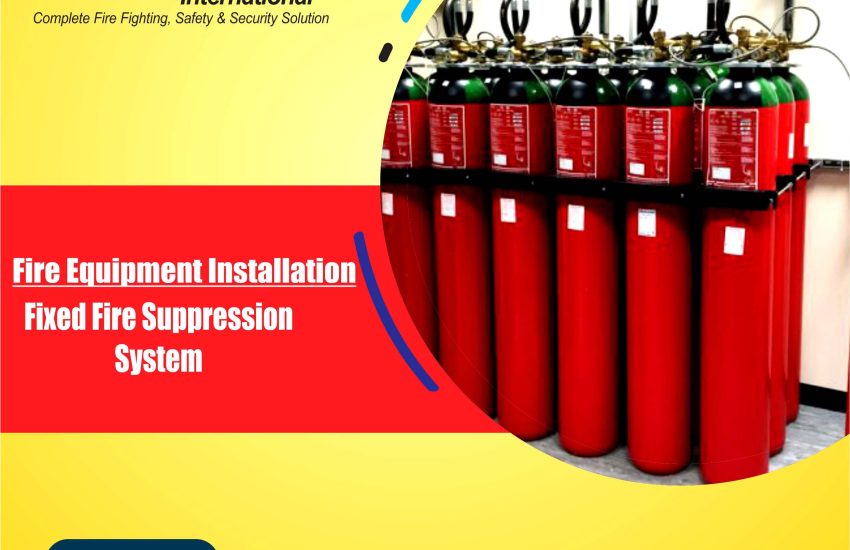What is a Fixed Fire Suppression System?
A Fixed Fire Suppression System is a permanent installation that automatically detects and extinguishes fires within a building or facility. Unlike portable fire extinguishers, which require manual activation, these systems are continuously monitored. They use suppression agents such as water, foam, CO2, or dry chemicals to combat fires. Fixed systems provide 24/7 protection, especially in high-risk environments.
Transition: Let’s now explore the different types of fixed fire suppression systems used across various industries.
Types of Fixed Fire Suppression Systems
Several types of fixed fire suppression systems are designed for specific hazards. Here are the most common systems:
1. Water-Based Fire Suppression Systems
Water-based systems are the most common type. These include:
- Wet Pipe Systems: These systems feature water-filled pipes that remain pressurized. When a fire occurs, heat activates sprinkler heads, releasing water to suppress the fire.
- Dry Pipe Systems: These systems use pressurized air or nitrogen inside the pipes. When a fire is detected, the air pressure drops, allowing water to flow into the pipes and activate sprinklers.
Transition: While water-based systems provide effective fire control, they may not suit all environments. Let’s discuss foam-based systems.
2. Foam-Based Fire Suppression Systems
Foam-based systems are ideal for areas with flammable liquids, such as fuel storage tanks. These systems use foam agents to suppress fires by forming a barrier that cuts off oxygen and cools the flames. Foam-based systems excel at preventing fire spread in hazardous areas like chemical plants.
Transition: Foam systems work well for liquid fire hazards. However, certain environments require gas-based suppression. Let’s explore these next.
3. Gas-Based Fire Suppression Systems
Gas-based systems use inert gases like CO2 or nitrogen to suppress fires. These systems are perfect for environments with sensitive equipment, such as server rooms and data centers. The gases displace oxygen, smothering the fire without damaging equipment.
- CO2 Fire Suppression Systems: These systems use carbon dioxide to reduce oxygen levels, extinguishing the fire.
- Inert Gas Systems: These systems use gases like nitrogen or argon to lower oxygen levels and suppress the fire.
Transition: Gas suppression systems are ideal for protecting electronics. Let’s look at chemical suppression systems now.
4. Chemical Fire Suppression Systems
Chemical suppression systems are commonly used in commercial kitchens, where oils and fats present a significant fire risk. These systems use wet chemicals to extinguish flames quickly and prevent re-ignition. They work efficiently in environments where specific fire risks demand a rapid response.
Transition: Chemical suppression systems act quickly and are ideal for kitchens. Now let’s dive into how these systems operate.
How Fixed Fire Suppression Systems Work
Fixed fire suppression systems rely on several key components that detect and suppress fires automatically. Here’s how they generally work:
- Detection: The system uses smoke detectors, heat sensors, or flame detectors to detect a fire.
- Activation: Once the system detects a fire, it automatically releases the suppression agent (water, foam, gas, or chemicals).
- Suppression: The suppression agent works to cool the fire, remove oxygen, or interrupt the chemical process that sustains the fire, effectively extinguishing it.
Transition: Fixed fire suppression systems offer many benefits. Let’s look at how they protect both property and people.
Benefits of Fixed Fire Suppression Systems
Investing in a fixed fire suppression system provides several key advantages:
- Automatic Activation: These systems activate automatically when they detect a fire, ensuring a rapid response even if no one is present.
- Continuous Protection: Fixed fire suppression systems provide 24/7 protection, which is critical in high-risk areas where constant monitoring is essential.
- Minimized Property Damage: A quick response helps limit damage to property and prevents the fire from spreading.
- Regulatory Compliance: Installing these systems ensures compliance with local fire safety regulations and standards, such as those set by the National Fire Protection Association (NFPA).
Transition: While the benefits are clear, proper installation is essential for the system’s effectiveness.
Fixed Fire Suppression System Installation Process
Proper installation ensures that the fire suppression system functions optimally. The installation process typically involves the following steps:
- Site Assessment: Professionals conduct a thorough evaluation of the site to assess fire hazards, the building layout, and the best suppression system for the facility.
- System Design: Based on the site assessment, the system is designed to meet the facility’s specific needs, including the placement of detectors, suppression agents, and nozzles.
- Installation: Once the design is approved, certified technicians install the system, ensuring that all components are properly placed and function correctly.
- Testing and Commissioning: The system undergoes rigorous testing to verify that it activates correctly and suppresses fires as intended.
Transition: Installation is just the first step. Regular maintenance is necessary to keep the system in top condition.
Maintenance of Fixed Fire Suppression Systems
Routine maintenance ensures the fire suppression system continues to function efficiently. The following steps are essential:
- Annual Inspections: Professionals should inspect the system at least once a year to check for any signs of wear or damage.
- Component Testing: Regular testing of detectors, valves, and suppression agents ensures the system will operate properly in the event of a fire.
- System Cleaning: Keeping the system clear of debris and obstructions is crucial for maintaining its performance.
Transition: By following these maintenance steps, you can ensure your fire suppression system remains reliable.
Conclusion
Fixed Fire Suppression System is essential for protecting high-risk environments from fire hazards. Whether using water, foam, gas, or chemicals, these systems provide tailored protection for each environment. Proper installation and regular maintenance are key to ensuring the system works effectively. By following recommended guidelines, you ensure reliable protection when you need it most.


